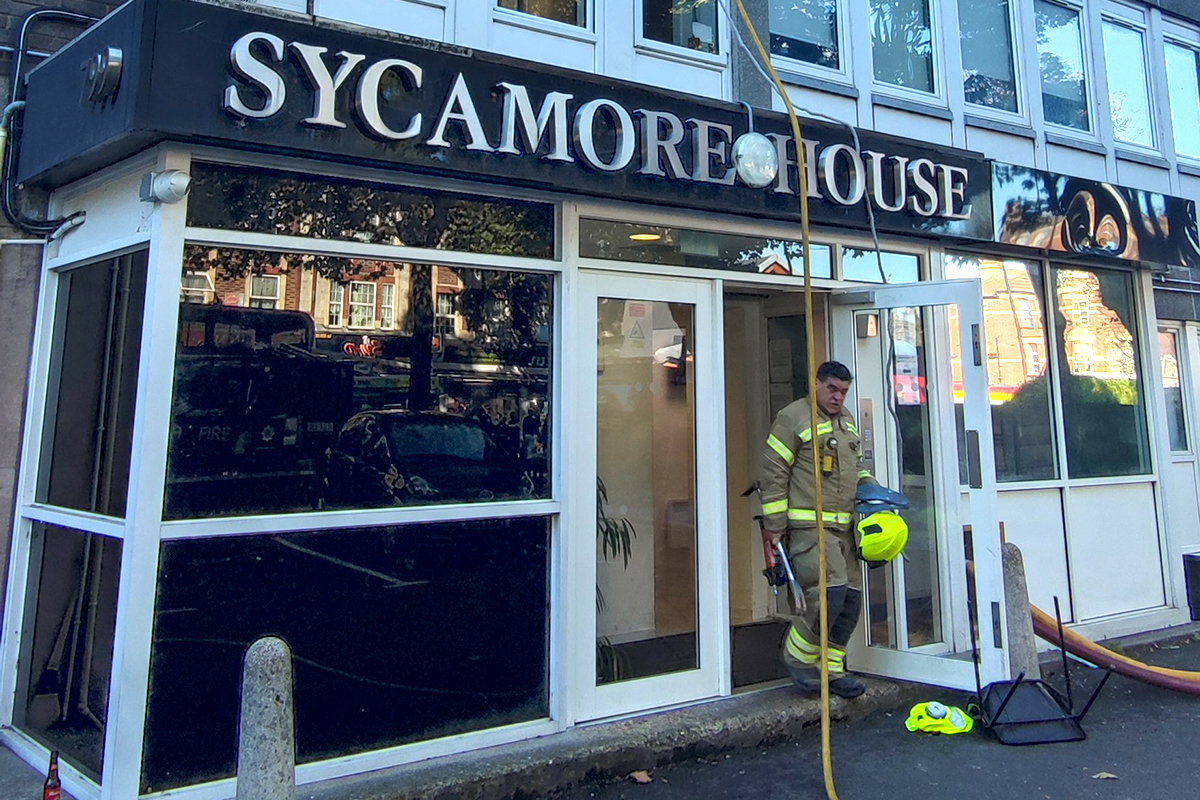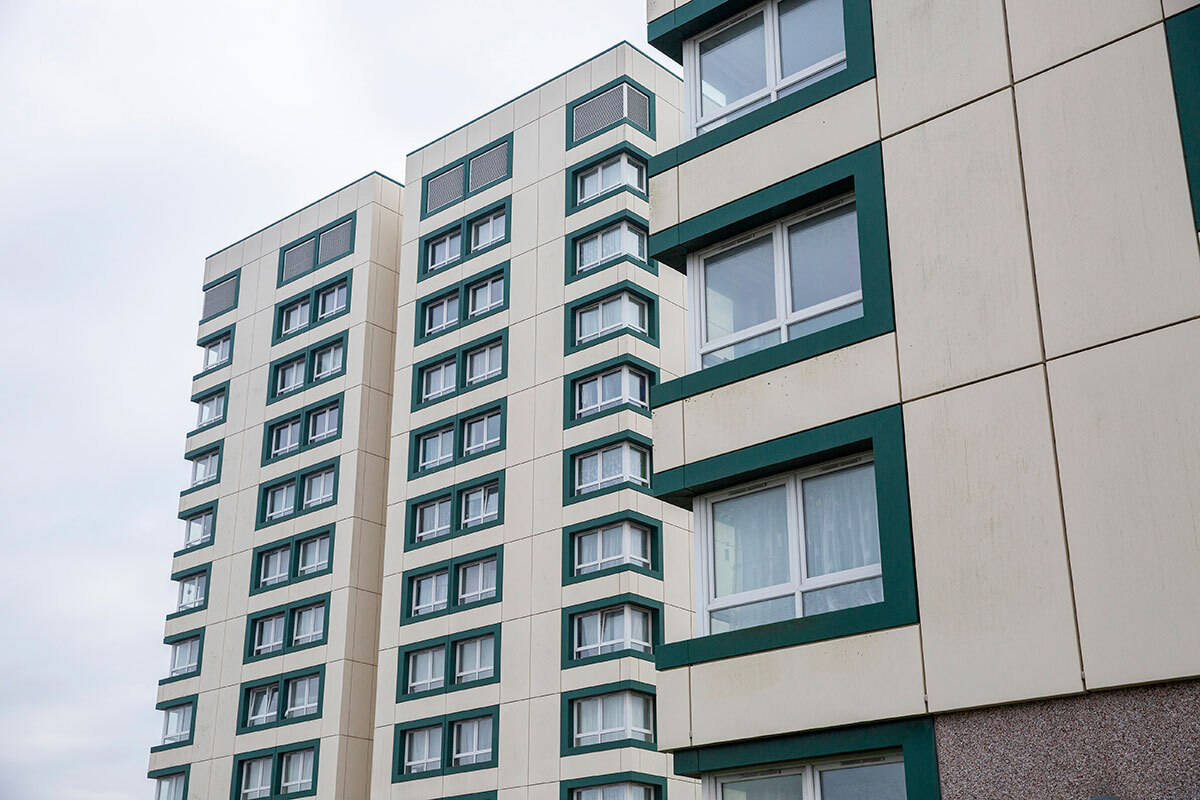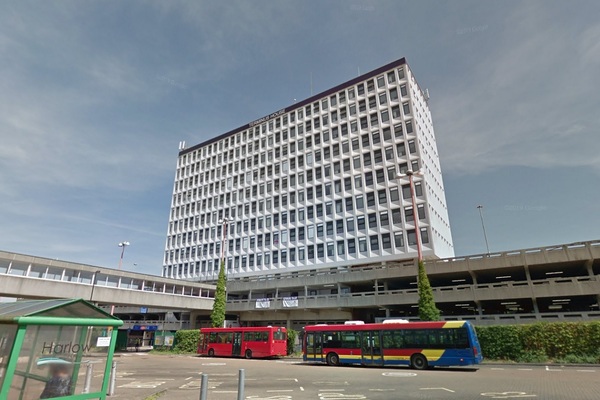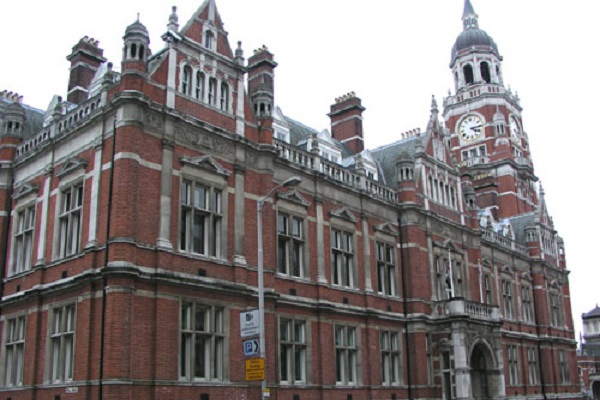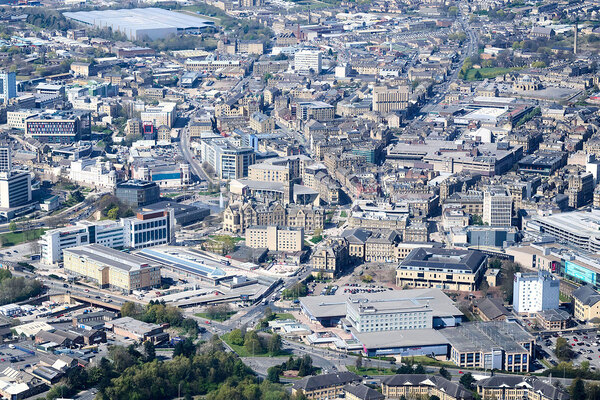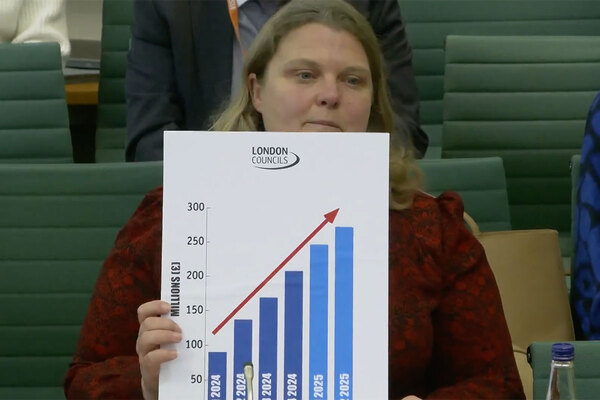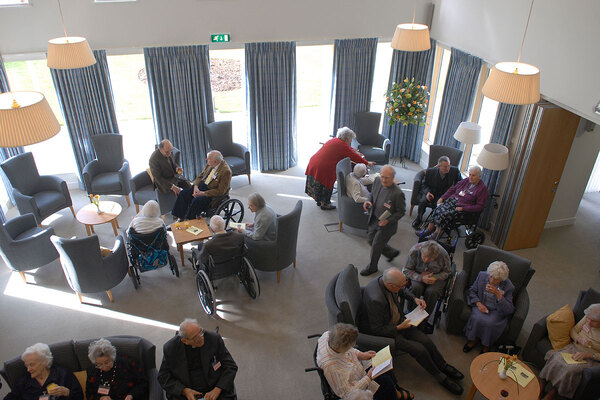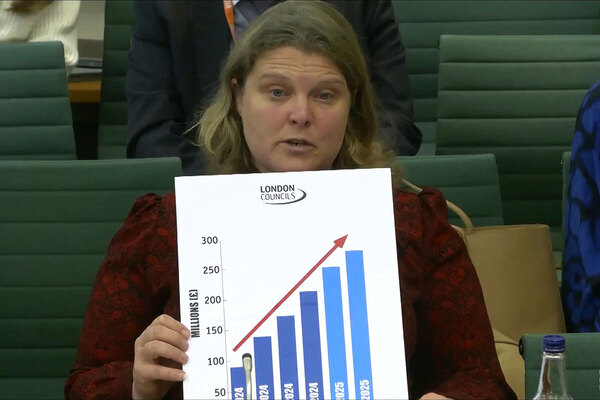‘We knew it was unsafe’: the story of a fire in a temporary accommodation block and its aftermath
A fire in a converted office block being used for temporary accommodation in Croydon in October forced its occupants to leave. The fire revealed three facets of the housing crisis: homelessness, building safety and the struggles to respond to a disaster. Peter Apps reports
“It was unsafe. And we knew it was unsafe,” says Natalie*.
By 8 October this year, Natalie had lived in Sycamore House, Croydon for more than three years, sharing a one-bed studio apartment with her infant daughter.
Sycamore House is an anonymous-looking six-storey building on a main road in the south London borough. It is one of three former office blocks on the same road that the council purchased in 2015 for conversion to temporary housing.
Life was already difficult for the residents of Sycamore House, the majority of whom were mothers with their children.
“Everything was broken. I had a massive hole in my bathroom sink, I couldn’t use it,” says Natalie. “Whenever we were indoors, we were just in bed. It was literally just a bed and a kitchen and a bathroom.”
For Claressa*, this was even harder. She came to the council as homeless with her 11-year-old son after her private landlord evicted her to do work on the property.
By the time she moved into Sycamore House in 2020, she had already been in temporary accommodation for two years. She was given a studio flat with her son – now 13 – meaning the pair had to share a bed. He was 15 by the time of the fire.
“It’s a large chunk of his teenage years just gone,” she says. “He has missed out on so much: birthdays and Christmas were just miserable.”
But things were about to get worse.
Alarm not heard
At around 1pm in the afternoon on 8 October, Natalie was taking a shower. Her daughter was with a relative and she was home alone. She was playing music via a bluetooth speaker in her bathroom, which meant she did not hear the fire alarm.
“The fire alarm was so quiet and I would never hear it,” she told Inside Housing. “I told the building manager it was too quiet, and he’d just said, ‘Oh, is it?’ No one ever spoke to me about safety or what to do in a fire.”
Coming out of the shower, she heard the alarm on the landing and opened the door to her flat.
“I went to the door in my towel and opened it and there was just thick black smoke coming from both directions,” she recalls. “I have never seen smoke like it in my life. Saying it was thick doesn’t do it justice. I ran back into my flat. I thought, I can’t get out, I’m going to die in here.”
A video of the fire recorded by a resident
Natalie opened the window (the security catch was broken, meaning she could open it wider than she would otherwise have been able to) and screamed for help.
“People were filming me on their phones, which was really horrible. The firefighters told me to come out of the building, but I thought if I took one step out into the corridor, I would die,” she says.
Eventually, she heard banging on her door. Firefighters had arrived with an oxygen mask and led her out through the smoke to safety. She was led to an ambulance and taken to hospital. Another mother was also rescued with her child and taken out of the building.
Claressa, who lived on the ground floor with her teenage son, left the building when she heard the fire alarm.
She thought the fire would just be a minor incident: the alarm had sounded several times previously without a major incident. But when she got out, she saw smoke billowing out of the windows. “I said to myself: this one is for real,” she says.
The fire happened in the middle of the day, but an incident later at night when all 70 flats were full could have had far more devastating consequences.
It is not yet known what caused the fire – which the London Fire Brigade (LFB) believes was started by a tea light – to rip through the building so fast, but documents obtained by Inside Housing paint a worrying picture.
Croydon, like most London boroughs, has a problem with homelessness and thousands of families in need of emergency housing every year.
Converting some empty offices to flats may have appeared a neat solution at the time. But there have long been fears about fire (see box below).
Remedial work
In September 2018, as local website Inside Croydon reported, the buildings were inspected by the LFB and served with enforcement notices demanding urgent remedial work.
At Sycamore House, the problems identified included many of the fire doors being damaged with excessive gaps around entrances, an emergency plan which was “not subject to effective monitoring or review”, excessive use of combustible pink foam in escape routes and insufficient protection for the escape route residents would use in a fire. The council was given until March 2019 to fix the issues.
Work was carried out, with the residents still in the building. “We feel we are living in a fire trap,” one told Inside Croydon.
Documents released to Inside Housing by the LFB under the Freedom of Information Act this month show the work progressed sluggishly. By March 2019, Croydon was given an extension on all three properties. By January 2020, a further letter confirmed most of the work had been completed to a satisfactory standard.
But by March 2021, the LFB was concerned again. It once more wrote to Croydon about Sycamore House, with a list of fire safety issues which resulted from a repeat inspection.
These included a warning that the “emergency routes or exits were inadequate” and the council “had not ensured that a suitable system of maintenance was in place” for the building.
The fire alarm was showing a fault and several significant findings from the fire risk assessment had not been implemented, including the need to assess “the potential risks to the premises from the cladding systems on the facade”.
Croydon has not yet released the building’s risk assessment, despite it being requested under the Freedom of Information Act by Inside Housing.
What happened next is not entirely clear, but several former residents have confirmed that a four-person waking watch was imposed at the building.
By the time of the fire, it had been reduced to just one security guard. Residents say this proved ineffective during the fire.
“We feel we are living in a fire trap”
“The security guard couldn’t do anything,” says Natalie. “He realised it was a real fire and knocked on as many doors as he could really quickly, but he couldn’t get across five floors. It just goes to show that the system doesn’t work. How can they play with lives like that?”
Shockingly, the residents, despite being homeless and waiting for permanent accommodation, were paying more than £100 a month in service charges to cover the cost of this waking watch service. Some of them say they continue to be billed even after the fire.
In a statement to Inside Housing, Croydon said: “All fire safety works had been carried out at the building, staff were fully trained in fire safety and evacuation procedures, and following their investigations, the London Fire Brigade has confirmed they will not be serving a notice of fire safety deficiency.”
It added that its insurers are satisfied works to the building were undertaken.
After being sent to hospital for treatment for smoke inhalation, Natalie returned to south London at 5pm.
At around 8pm, she was told to go to a local leisure centre, where she found her neighbours sitting around drinking water and eating biscuits. She says she had to argue with the council officers to get more substantial food provided. Once she did, they went to Tesco and brought some meal deals.
“It felt like they don’t care – like they didn’t care about us. There was no compassion. They were walking around smiling and it was all like a photo opportunity for them. They weren’t really there for us. They were looking at us like it was our fault. No one thought, ’Look at these kids, they might be hungry, let’s order some pizza,’” she says.
Claressa had left Sycamore House in her slippers and cardigan, and had not been allowed back in. Her phone had run out battery life. She and her son only ate because another resident bought them some food.
Then they saw council officers blowing up mattresses and realised the plan was for them to sleep in the sports centre. “I said, ‘No, I have nearly died – do you think I’m going to sleep in a sports centre?’” says Natalie.
The council relented and booked hotels near Gatwick Airport – due to a lack of availability nearby. For the 51 families evacuated from Sycamore House, this was the first step in a grind of moves from hotel to hotel, often with limited information from the council. Eight households continue to wait for alternative temporary housing.
A council spokesperson says setting up the rest centre in Thornton Heath Leisure Centre “took longer than we would have liked, which we know was difficult for residents and we are reviewing our processes to see where we can improve”.
But they added officers then worked “through the night to swiftly arrange accommodation, provide transport to hotels and secure care for more vulnerable residents”.
Told to leave hotel
One resident, Tamsyn*, recalls how at one stage, she was told by the council she could stay at a hotel until Friday. But the hotel management insisted she should be out by Wednesday and when she refused to leave (all her belongings were in the hotel room and she had no transport), they phoned the police.
“It was so embarrassing and so traumatising for my son,” she tells Inside Housing.
The families were given food vouchers to redeem for food at the local BoxPark complex of fast food and bars. This is not a great selection of food for children, particularly Tamsyn whose son has Crohn’s disease and must carefully monitor his diet.
“They treated us like: whatever we get we should be grateful for,” says Natalie.
For Natalie, who also has mobility issues following an operation, walking to BoxPark for food every meal time with her infant child is impossible. She recalls agreeing on the phone with a council officer that she would get food delivered via Uber Eats instead. But when she asked the council about this, she was bluntly told in an email seen by Inside Housing: “You imagined it.”
The council spokesperson adds: “For weeks after the incident, we based welfare teams at the hotels seven days a week, and staff worked tirelessly to provide a range of practical help, making sure everyone had food, vouchers and other essential supplies, as well as working with partners like the Samaritans to make sure residents were well and coping as best they could in what has been a very stressful time for them.”
Claressa, who had been sharing a bed with her 15-year-old son at Sycamore House, was offered another property with only one bed – telling her that she would only get another bed if she had two or three children. She felt she could not accept it, knowing how much her son, who has ADHD, had struggled at Sycamore House.
“He would get frustrated – he smashed a glass into the wall out of anger and frustration. He said, ‘They are never going to give us a house, we are going to live like this forever.’ He said he was not going to go to school – he just lost hope in everything,” she says.
The stress has exacerbated health problems for Claressa, who was taken to hospital at one point with heart problems. She has now accepted a two-bedroom flat, but it is above a shop and Claressa has mobility issues which means she walks with a stick and struggles with stairs. After the fire, she is worried about being placed above the ground floor.
When Natalie missed a call from a letting agent to discuss a potential property, she received an email from the council within a few minutes.
“If you fail to communicate with the lettings team [today], we will deem that you will have refused this offer. The council will then discharge its full duty and evict you from your hotel accommodation. If you apply to any other council, it will be deemed you have made yourself intentionally homeless,” the email said.
“It was the first I’d heard about the offer,” she says. “I feel like I’m being treated worse because I’m the one who has been raising complaints.”
The stress has had an impact – for her and her daughter. “It’s really affected my daughter’s behaviour. We normally go to play groups or dance classes, but we haven’t for weeks. When we were going from the hotel, she said she didn’t want to go to another hotel, she wanted to go to mummy’s house. She talks about the fire a lot. She tells me not to cry,” says Natalie.
“They treated us like: whatever we get we should be grateful for”
Croydon says it has found alternative accommodation for all but eight of the 51 residents, and provided a £500 payment when residents moved in to their new homes.
Rhiannon Hughes is community engagement manager at South West London Law Centre, which has been working with the Sycamore House community and supports other families in temporary accommodation.
She says that the experiences Inside Housing has heard about are “not isolated”. “Every family has a different level of vulnerability, and not all of them will describe it in quite the same way,” she adds.
“With temporary accommodation, it’s seen that people should be grateful for whatever they are given and that’s the attitude across the board,” she says.
“There are other examples of blocks like Sycamore House. The fact that there was a fire brought a lot of this to the foreground. A mum having to share a bed with her male teenage son shouldn’t be right at any point, but people don’t want to complain because they don’t want to jeopardise themselves.”
South West London Law Centre is calling on Croydon Council to commit to a new action-based quarterly temporary accommodation forum and work with its temporary accommodation group to create a new policy.
Professor Lucy Easthope, an expert in disaster management, says the council’s response is concerning.“This raises big questions for Croydon. I think London boroughs are in a bit of a crisis when it comes to disaster response,” she says. “Ten years ago, it was a much better service for those kind of emergencies, but it has just been eroded.
“They are not responding with heart. Yes, there are huge challenges finding decent housing, but you have to ask yourself: is this how I would want to be treated?”
This story brings together three crises: the huge homelessness crisis which is at its most severe in London; the endemic building safety issues plaguing our housing stock and the struggles with disaster response, particularly when rehousing is required.
At the epicentre of all these systemic failures are mothers and their children, who just want the most basic of human rights: a decent, secure and safe place to call home.
*Names have been changed
Are office to residential conversions a fire risk?
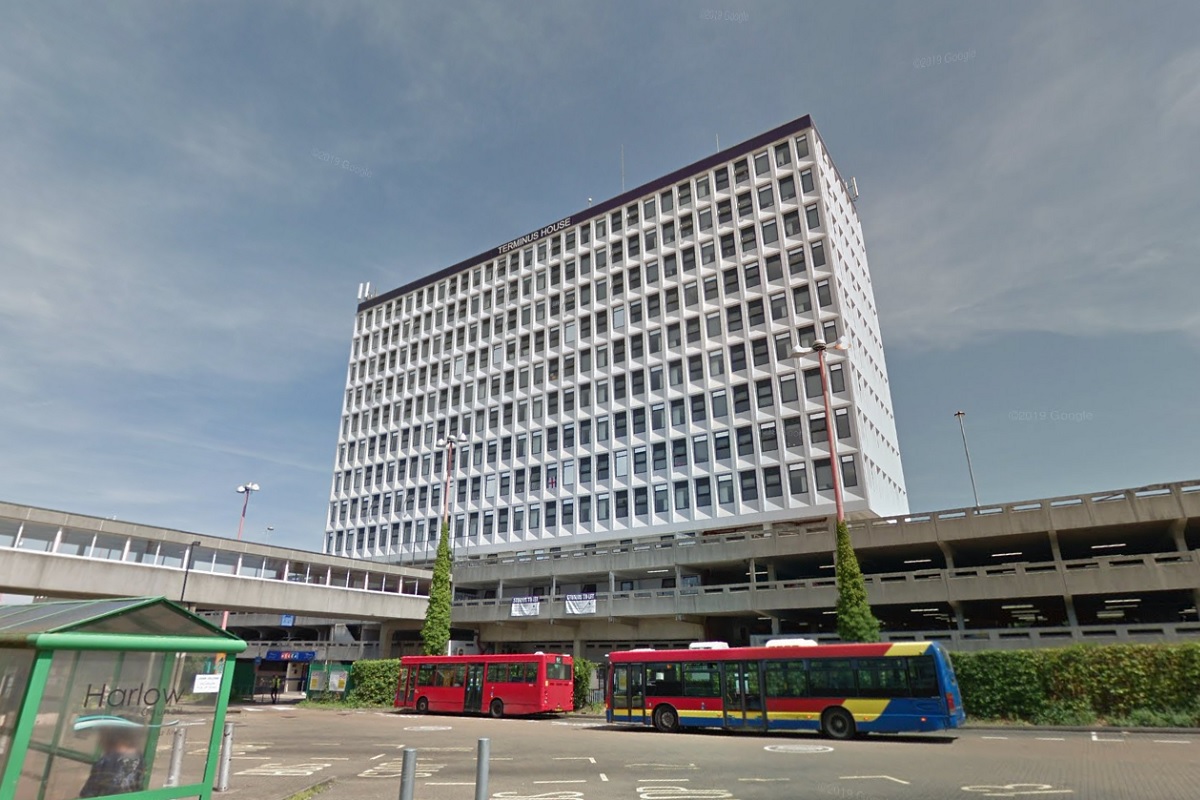
Office-to-residential conversions took off in the early 2010s. The recession had left many office blocks vacant, and the government spotted an opportunity to help meet rising housing demand.
The conversions were deemed a ‘permitted development’ – meaning traditional planning permission was not necessary – in 2013.
While this has delivered thousands of new homes in the decade since, it has also had some well-publicised downsides.
The lack of planning oversight means affordable housing contributions can’t be applied and local authorities lose the power to say no to new developments in areas where they don’t make sense – such as an out-of-town business park with no facilities. They also lose employment space if working offices are converted.
Croydon has been among those to campaign on this issue.
A review by the Royal Institution of Chartered Surveyors (RICS) in 2018 said the policy had “allowed extremely poor-quality housing” to be delivered – including studio flats at less than half national space standards and “buildings with barely any changes done to convert from office to residential use”.
The report identified Croydon as a particular hotspot for these lower-quality developments, noting that there were some which raised “serious concerns” about “health and safety (particularly fire safety)”.
With no one sleeping and far fewer potential sources of ignition, the risk profile of an office is totally different to residential.
Almost all workplaces will be based on some form of simultaneous or phased evacuation, and will not have the ‘compartmentation’ necessary to support a stay put strategy. When they convert to residential, this needs to be built in.
“The areas of change between offices and residential in terms of Approved Document B [official fire safety guidance] are extensive,” says Adrian Buckmaster, founder of consultancy TetraClad. “There are different standards for the walls, the floor slabs, the compartmentation. You have to change the entire fabric of the building to bring it up to standard.”
In some instances, this is what is done: the interior is effectively ripped out leaving a shell which is built back up from the inside to residential standards. But this is not always the case.
Helen McKeown, technical director and head of building surveying at Thomasons UK, notes that the developer “doesn't always consider the original building or its envelope from a first principle basis in terms of its design”.
“They tend to ask their design team, ‘How many units can I get in this building?’ and ‘Can I add storeys on top?’ The development appraisal is driven by the bottom line ultimately,” she says.
She notes the importance of selecting the right materials. “Introducing a new combustible element to a building that has existing combustible elements can cause a ripple effect, significantly increasing the risk to life and spread of fire,” she says.
Andrew Furness, managing director at Salvus Consulting, says: “Obviously the change means that we will have to start making holes in those concrete slabs for services: the sewerage, all of the pipe work, the cabling. My concern once the hole and penetrations have been used is the quality of the fire-stopping to the areas.”
He adds that the final use of the building can affect the quality of the work. “The quality of the install and fire-stopping has unfortunately, on a number of occasions from my experience, been different depending on whether the building is for social housing or private dwellings. I do find this unacceptable,” he says.
Ms McKeown adds that the situation might improve: while office to residential sits outside the planning process, it is still covered by building control – which means it will come under the ‘gateway’ system introduced by new building safety laws. “An office-to-resi conversion application will have to go through the same ‘first principle’ safety and design checks that new builds will have to go through,” she says.
But if there are existing dangerous buildings already out there, it can only be hoped that they are found before a disaster.
Sign up for our homelessness bulletin
Already have an account? Click here to manage your newsletters
